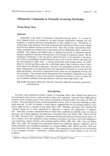Allelopathic Compounds as Naturally Occurring Herbicides
JIRCAS international symposium series
| ISSN | 13406108 |
|---|---|
| 書誌レコードID(総合目録DB) | AA1100908X |

本文フルテキスト
intlsymp-4_107-115.pdf324.49 KB
Allelopathy is the result of biochemical interactions between plants. It is caused by toxic chemicals which are released by the plant through volatilization, leaching, and root exudation or produced during the decomposition of plant residues in soil. Phytotoxins, including fatty acids, phenolics, flavonoids, terpenoids and alkaloids have been found in plants and soils from different habitats around the world. Since 1972, we have reported that allelopathic metabolites are released from woody plants, such as Phyllostachys edulis, Leucaena leucocephala, Vitex negundo, and Delonix regia, to suppress the growth of understorey species, causing a significant reduction of biomass and a low diversity of understorey plants. The development of dominance of the tree species mentioned above is due primarily to the phytotoxic effects of metabolites released from plant parts, such as leaves, flowers, and twigs, and the decomposition of fallen litter. A pasture grass-forest intercropping system was established by introducing kikuyu grass into a deforested region where coniferous trees or hardwood plants were allowed to regenerate. Because of the allelopathic potential of the kikuyu grass, weeds grown in the deforested land were suppressed by the grass six months after the grass was planted; the growth of regenerated forest plants was not suppressed, however, but was stimulated. This example clearly demonstrated that allelopathic compounds can be used as natural herbicides to control weed growth in agricultural practice in order to reduce the use of synthetic herbicides, avoid agrochemical runoff and reduce high labour costs.
| 作成者 | Chang-Hung Chou |
|---|---|
| 著者キーワード | allelopathy phytotoxin phenolics flavonoid alkaloids sustainable agriculture allelochemicals |
| 公開者 | Japan International Research Center for Agricultural Sciences |
| オンライン掲載日 | |
| 号 | 4 |
| 開始ページ | 107 |
| 終了ページ | 115 |
| 言語 | eng |
